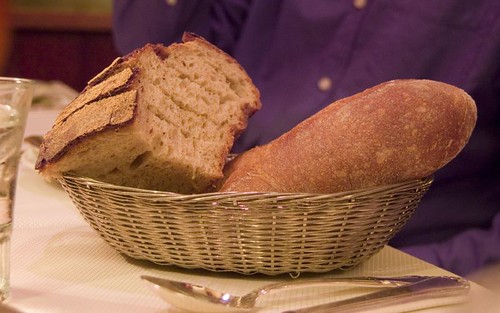Some parts of this are relatively new to me, so I have a lot to learn yet. This is a true beginner's guide:
 Wheat is one of the three top crops produced in the United States. (This can be bad, but I'll save that post for another time!) Therefore, we eat a lot of it: bread products in particular(at least in my country, and probably many countries around the world). Although we consume large volumes, most of us don't know much about what we are eating.
Wheat is one of the three top crops produced in the United States. (This can be bad, but I'll save that post for another time!) Therefore, we eat a lot of it: bread products in particular(at least in my country, and probably many countries around the world). Although we consume large volumes, most of us don't know much about what we are eating.Now, how do we know what kind of bread is best to buy for our families?
Grocery Store Guide to Bread
![Bread [sliced]](http://farm1.static.flickr.com/104/296300763_daa85ee8aa.jpg) White Bread
White BreadThis is the kind of bread I used to pick up for less than fifty cents a loaf at my local Aldi's or Save-a-Lot stores. Even now, I can get a loaf of this for under a dollar at almost any grocery store. It is cheaper because it is the bread that has only one part of the wheat kernel in it, along with a host of other chemicals. As Robyn of Green Smoothie Girl puts it, it is mostly made up of the "glue" that holds the more nutritious parts of the kernel together. When you buy it in the store, it will usually say "enriched" on it, because they have to put some vitamins back into it artificially to prevent diseases like rickets.
Wheat Bread
Often wheat bread in the store is just the white bread with some coloring added to it. Even white bread is made from wheat---just not the whole kernel. Sometimes bread companies will add a little bit of whole grains to the enriched flour, but unless it says 100% whole wheat, you know that most of it is the plain old starch part of the wheat kernel.
100% Whole Wheat
This choice is better nutritionally, but as you can see from its label, it has a lot of unpronounceable things added that I'm generally not comfortable feeding to my family on a regular basis:
INGREDIENTS:Good bread with only 5 simple ingredients can be bought, but it is between $4 and $5 a loaf. The way my family eats bread, I cannot justify that expense in my budget.Which brings me back to my Little Red Hen nickname. I skip the growing the wheat part. I just started buying my own wheat berries in bulk (think 50 pounds of wheat berries sitting in the corner of my kitchen....no, I'm not kidding!).
Whole wheat flour, water, wheat gluten, high fructose corn syrup, contains 2% of less of: soybean oil, salt, molasses, yeast, mono and diglycerides, exthoxylated mono and diglycerides, dough conditioners (sodium stearoyl lactylate, calcium iodate, calcium dioxide), datem, calcium sulfate, vinegar, yeast nutrient (ammonium sulfate), extracts of malted barley and corn, dicalcium phosphate, diammonium phosphate, calcium propionate (to retain freshness). (Source)
When I need some flour for bread or some other wheat product, I toss some wheat berries into my Vitamix, push a button, and have fresh ground flour in one minute. I use it immediately and store any excess in the freezer. That's the extent of the milling part.
As for the baking, I'm honestly still experimenting with the perfect 100% whole wheat bread for our family. If you have a recipe that makes soft, not crumbly bread that is good for sandwiches in a bread machine with just a few simple ingredients (I don't ask for much, do I?), I would love for you to share it in the comments.
Right now, I adapt my homemade white bread recipe and it's pretty good for meals and such. Which is the eating part. My little "chicks" like it best fresh from the oven.
If you're past the beginner stage, here are a few links you might find helpful:
Grinding Your Own Wheat Is Not Crazy After All (with video demonstration)
Real Food Encouragement: Whole Wheat Bread
What Are Sprouted and Soaked Grains?
This post is linked to:


No comments:
Post a Comment